 J Clin Aesthet Dermatol. 2020;13(7):36–40
J Clin Aesthet Dermatol. 2020;13(7):36–40
by Mark C. Marchitto, MD, and Anna L. Chien, MD
Drs. Marchitto and Chien are with the Department of Dermatology at Johns Hopkins University School of Medicine in Baltimore, Maryland.
FUNDING: No funding was provided for this study.
DISCLOSURES: The authors have no conflicts of interest relevant to the content of this article.
ABSTRACT: Background. There is recent evidence linking rosacea to systemic disease.
Objective. We sought to identify correlations in Google searches (Google LLC, Mountain View, California) for rosacea and comorbid conditions to assess whether the public is seeking information regarding these trends.
Methods. Google search data from January 1, 2004, to February 28, 2018, for rosacea and search terms representing common comorbid conditions were investigated. This analysis included searches occurring in the United States (US), Canada, the United Kingdom (UK), and Australia. Search volume index (SVI) data were plotted over time and Pearson correlation coefficients were calculated from search data to assess for correlations between search terms.
Results. The level of interest in rosacea was highest in the spring and lowest in the winter in the US, Canada, and UK. Seasonal search trends in Australia were the inverse of those in northern hemisphere nations. Significant correlations were found between depression and rosacea SVI in the US (R=0.481; p<0.001), dementia and rosacea SVI in the UK (R=0.774; p=0.011), and hypothyroidism and rosacea SVI (R=0.752; p<0.001) in the UK. Additionally, search trends for irritable bowel syndrome (R=0.399; p<0.001) and ulcerative colitis (R=0.514; p=0.032) correlated significantly with rosacea in Canada and the UK, respectively. In Australia, search trends for osteoporosis significantly correlated with rosacea (R=0.394; p<0.001).
Conclusions. Our findings indicate growing interest among the general public regarding rosacea and comorbid diseases, which behooves clinicians to adopt a more comprehensive approach in managing rosacea patients.
Keywords: Infodemiology, epidemiology, public health, rosacea, comorbid disease, Google Trends
Rosacea is a common dermatologic condition that affects millions of individuals across the globe. It is estimated that approximately 5.46 percent of the general adult population is affected by rosacea, with onset typically occurring in middle age.1 Clinically, rosacea is characterized by papules and pustules superimposed on a background of erythema and telangiectasias in a central facial distribution.2 While the pathogenesis of rosacea remains unclear, there is mounting evidence linking rosacea to systemic conditions.3,4
In recent years, Egeberg et al5–8 have published numerous reports demonstrating correlations between rosacea and gastrointestinal, neurologic, and psychiatric disease. Additional studies have shown that patients with rosacea tend to have more systemic conditions relative to controls without rosacea.9–11 Evidence from these studies suggests rosacea might be an early skin manifestation of a primary inflammatory disease.
While these correlations are gaining interest in the medical community, it is unclear whether the general public is aware and seeking information regarding these trends. To address this question, we accessed publicly available Internet search data from one of the most popular search engines in the world, Google (Google LLC, Mountain View, California). Recent studies have found that, through the analysis of Google search inquiries, one can accurately predict and forecast current interests of the general public, allowing for the analysis of trends in both medical and nonmedical areas of interest.12–15 The use of Internet search data to draw conclusions on the determinants and delivery of health information is known as infodemiology.16,17
In our study, we used data acquired from Google to assess for correlations between search terms involving rosacea and systemic diseases to ascertain whether this is an area of emerging interest among members of the general public.
Methods
The data presented in this manuscript were collected from Google Trends (GT).18 GT is a free publicly available tool that calculates the quantity of searches for a given term relative to the total number of searches conducted using Google, allowing for the interpretation of the popularity of a search term or phrase over time. GT was adopted to study the degree of public interest and overall awareness in rosacea and diseases that have been linked to rosacea. The search term rosacea, along with 24 other search terms for common comorbid conditions, were investigated from January 1, 2004, to February 28, 2018, in four majority English-speaking countries: the United States (US), Canada, the United Kingdom (UK), and Australia. Search volume index (SVI) data were plotted over time. A total of 96 comparisons were made, as 24 search terms for common comorbid conditions were compared to the search term rosacea across the four countries. Pearson correlation coefficients were calculated from search data to assess for associations between search terms in a time-dependent manner. A significant correlation coefficient close to 1 suggested that two search terms were searched at similar frequencies for that given month, allowing for reflection on the seasonal popularity of search terms over a period of several years. Statistical analysis was performed using the SPSS Statistics version 25.0 software program (IBM Corp., Armonk, New York) with significance level of p<0.05.
Results
Interest in rosacea was highest in spring months (i.e., March, April, and May) and lowest in winter months (i.e., December, January, and February) in the US, Canada, and UK from January 2004 to February 2018 (Figure 1). Seasonal search trends in Australia were the inverse of those observed in northern hemisphere nations, with the highest rosacea SVI seen in winter months and lowest rosacea SVI seen in spring months. These findings correlate with the reversal of winter and summer seasons in the southern hemisphere relative to the northern hemisphere.
 Search trends for rosacea and common comorbid conditions presented several significant correlations (Table 1). Trends for the gastrointestinal disorders irritable bowel syndrome (IBS) (R=0.399; p<0.001) and ulcerative colitis (R=0.514; p=0.032) correlated significantly with rosacea in the Canadian and UK cohorts, respectively. Notably, no correlations were found between search trends for Crohn’s disease and rosacea across all four nations studied.
Search trends for rosacea and common comorbid conditions presented several significant correlations (Table 1). Trends for the gastrointestinal disorders irritable bowel syndrome (IBS) (R=0.399; p<0.001) and ulcerative colitis (R=0.514; p=0.032) correlated significantly with rosacea in the Canadian and UK cohorts, respectively. Notably, no correlations were found between search trends for Crohn’s disease and rosacea across all four nations studied.
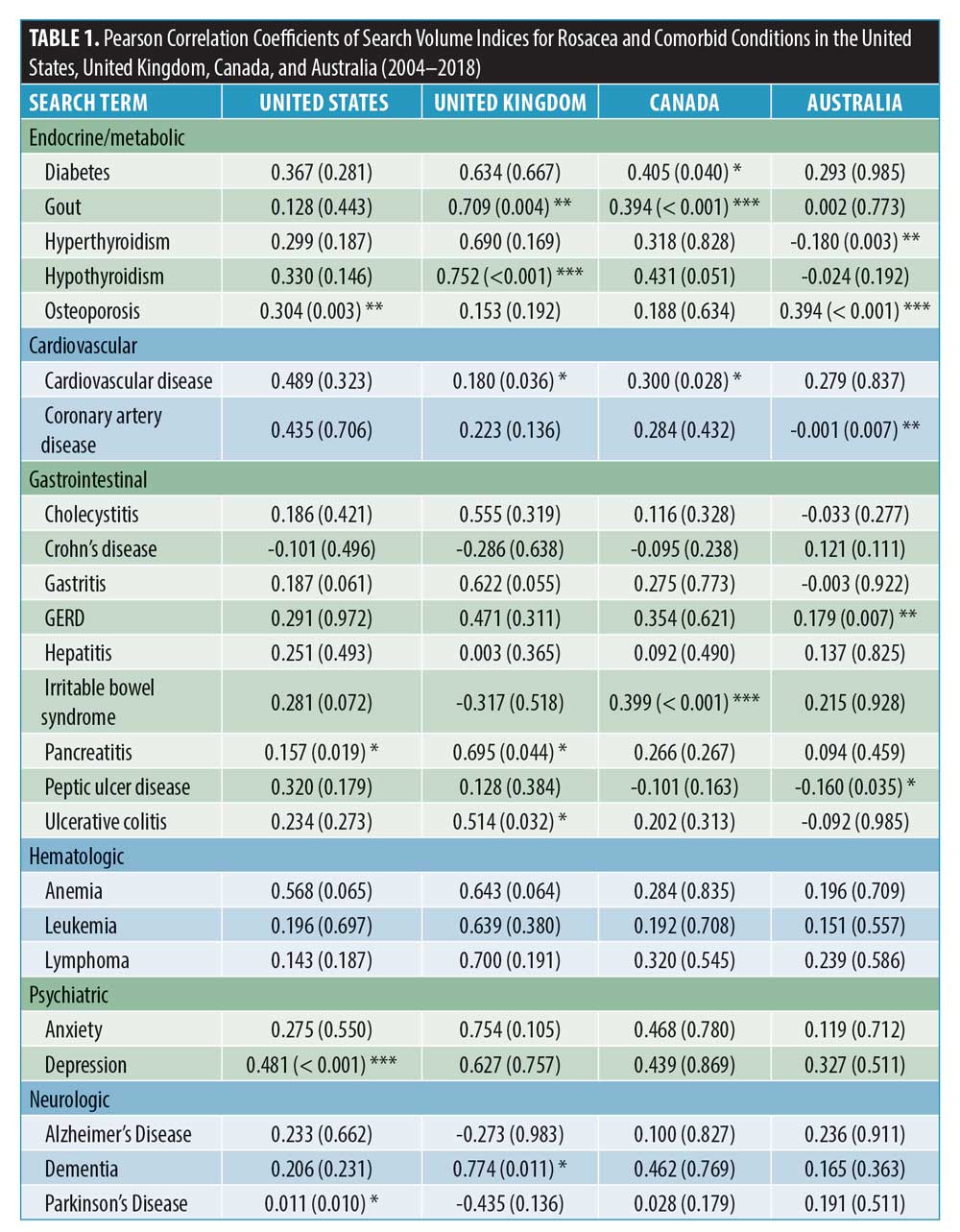 In regards to neuropsychiatric search terms, a significant correlation was found between rosacea and depression SVI data in the US (R=0.481; p<0.001) (Figure 3). No significant correlation was found between the two search terms in the UK, Canada, or Australia. A very strong positive correlation between dementia and rosacea SVI data was found in the UK (R=0.774; p=0.011) (Figure 4). Parkinson’s disease and rosacea SVI data did not significantly correlate with one another in the UK, Canada, or Australia and were only weakly correlated in the US (R=0.011; p=0.010).
In regards to neuropsychiatric search terms, a significant correlation was found between rosacea and depression SVI data in the US (R=0.481; p<0.001) (Figure 3). No significant correlation was found between the two search terms in the UK, Canada, or Australia. A very strong positive correlation between dementia and rosacea SVI data was found in the UK (R=0.774; p=0.011) (Figure 4). Parkinson’s disease and rosacea SVI data did not significantly correlate with one another in the UK, Canada, or Australia and were only weakly correlated in the US (R=0.011; p=0.010).
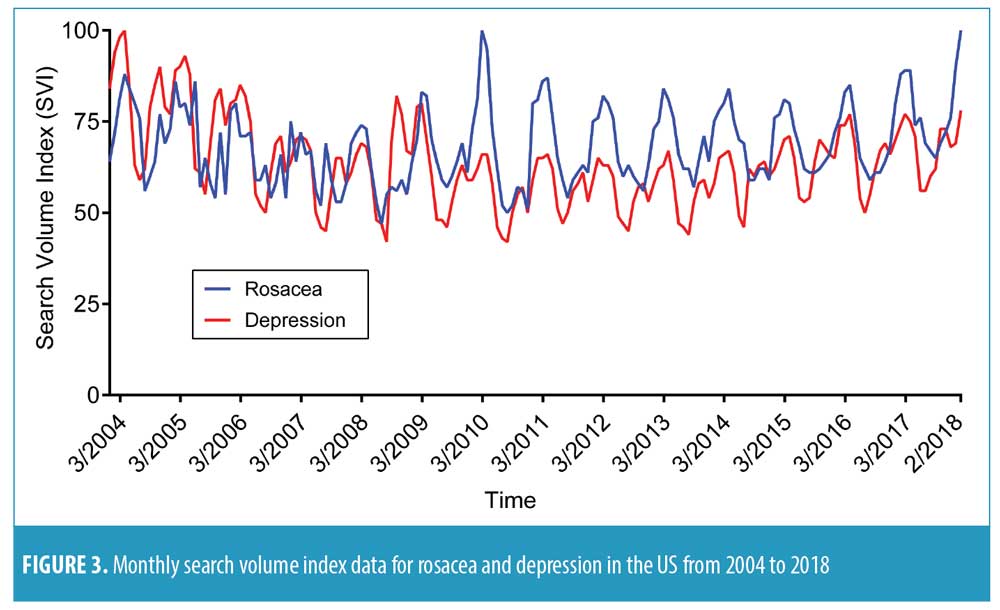
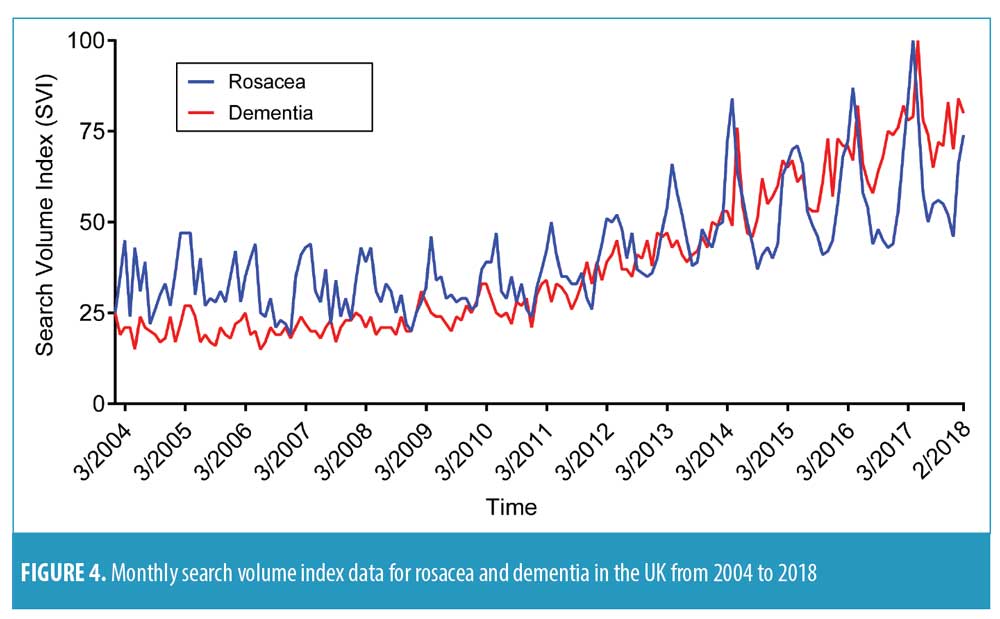
Meanwhile, a robust correlation was found between rosacea and hypothyroidism SVI data (R=0.752; p<0.001) in the UK (Figure 2), while a significant negative correlation was noted between rosacea and hyperthyroidism SVI data in Australia (R=–0.180; P=0.003). Google searches for diabetes and rosacea were modestly correlated in Canada (R=0.405; p=0.040) (Figure 5) but were not correlated in the US, UK, or Australia. Search trends for osteoporosis were significantly correlated with rosacea in Australia (R=0.394; p<0.001) and the US (R=0.304; p=0.003).
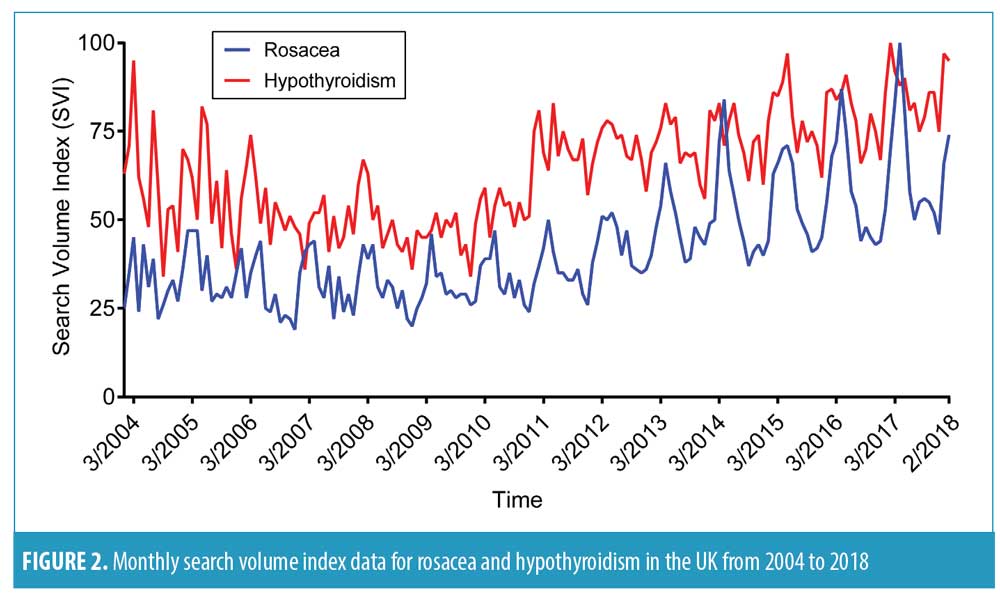
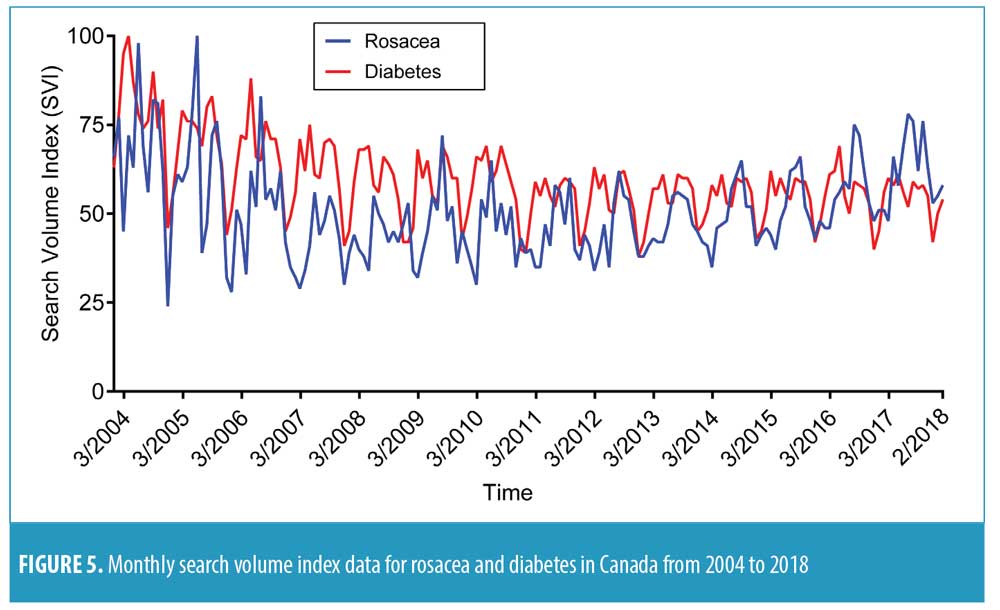
Discussion
Rosacea is a common chronic inflammatory skin condition recently linked to a number of comorbid conditions. Paired with the increasing awareness of associations between rosacea and systemic disease, our results demonstrate several strong correlations exist in the public’s interest in rosacea and comorbid diseases. These correlations were strongest for gastrointestinal (IBS and ulcerative colitis), neuropsychiatric (depression and dementia), and metabolic conditions (hypothyroidism, diabetes), all of which have been linked to rosacea in previous studies. While the aforementioned associations were not significant across all nations studied, our results suggest there is a relationship between searches for rosacea and common comorbid conditions in specific cohorts and these relationships appear to be seasonal in nature. It is possible the variations seen between the countries studied are multifactorial, as environmental, societal, and cultural factors are likely at play. These influences might contribute to greater prevalence rates of certain comorbidities or higher levels of individuals’ interest in certain diseases.
Recent epidemiologic investigations have proposed links between inflammatory bowel disease, including ulcerative colitis and Crohn’s disease, and rosacea.7,19,20 In our study, we found a strong positive correlation between the search terms ulcerative colitis and rosacea in the UK cohort. Concerning the associations between search terms for neuropsychiatric conditions and rosacea, dementia was strongly correlated with rosacea in the UK cohort, coinciding with a nationwide Danish study of more than one million patients that linked rosacea to an increased risk of developing dementia.6 Despite the link found between rosacea and Parkinson’s disease in a separate Danish investigation, however, no significant correlations were found between search terms for these two disorders in our study.21
Interestingly, we observed a robust seasonal trend between rosacea and hypothyroidism—an association that has yet to be extensively explored. The peak and trough values of the rosacea and hypothyroidism SVI data shown in Figure 2 demonstrate a clear seasonal trend, which raises the question of whether the two medical conditions are linked. Chronic inflammation is known to play a role in both rosacea and hypothyroidism. Of note, it has been suggested that patients with rosacea have a higher incidence of thyroid cancer.10
Osteoporosis and cardiovascular diseases, such as coronary artery disease, are prevalent comorbid conditions affecting the aging female population in particular. In our study, we found significant correlations existed between rosacea and osteoporosis SVI data in Australia and the US, and between rosacea and cardiovascular disease SVI data in Canada. Given these correlations, it may be beneficial to screen female patients with rosacea for cardiovascular disease and osteoporosis at a younger age than those without rosacea. We feel that further investigation of the aforementioned associations is warranted.
Previous studies have also suggested seasonal trends exist in Google searches for the dermatologic conditions melanoma and skin cancer, with peak SVI data recorded in the summer months.22,23 In our study, we report the novel finding of rosacea SVI peaks in the spring months, further implicating that environmental factors heavily influence flares in dermatologic conditions.24 Given that sunlight is thought to result in rosacea flares, this finding is likely a direct consequence of increased sun exposure during the spring and summer months.25
Limitations. The limitations of GT include data being captured from only a portion of the population with access to Google as well as the inability to collect information from other search engines, such as Yahoo and Bing. Additionally, it is important to keep in mind the interpretation of our data. As we stated previously, a correlation coefficient close to 1 suggests that two terms are highly correlated, meaning they were searched at similar frequencies during a given time period. Our results do not necessarily imply that terms were searched together in a single search inquiry, for example: “is rosacea related to colitis?” Furthermore, a study by Sadah et al26 published in 2015 investigated the age distribution of Google Health users and found that a majority of these individuals (53.21%) were aged 18 to 34 years, whereas only 19.02 percent and 2.46 percent were in the age ranges of 45 to 64 years and 65 years or older, respectively. This suggests a potential mismatch between the individuals using Google and those experiencing comorbid disease. However, Internet use is growing among older generations. It is also important to note that researchers investigating rosacea comorbidities are likely performing Google searches; however, we believe the number of laypersons conducting these searches far outnumbers the researcher cohort. Our study is solely observational, as we did not compare rosacea cases with Google searches for rosacea and conclusions drawn must be validated in cohort-based investigations. Future directions of our research include comparing trends of cases of new-onset rosacea and rosacea flares to rosacea search data acquired from Google.
Conclusion
In summary, our results demonstrate several strong correlations exist in the public interest in rosacea and comorbid diseases. Our findings indicate a growing interest among members of the general public regarding rosacea and comorbid diseases, which behooves clinicians to take a more comprehensive approach in managing patients with rosacea. Finally, our study highlights the growing research discipline of infodemiology as an important and vital methodology for analyzing health information and which is capable of providing valuable insights to clinicians and epidemiologists alike.
References
- Gether L, Overgaard LK, Egeberg A, Thyssen JP. Incidence and prevalence of rosacea: a systematic review and meta-analysis. Br J Dermatol. 2018;179(2):282–289.
- van Zuuren EJ. Rosacea. N Engl J Med. 2017;377(18):1754–1764.
- Rainer BM, Fischer AH, Luz Felipe da Silva, et al. Rosacea is associated with chronic systemic diseases in a skin severity-dependent manner: results of a case–control study. J Am Acad Dermatol. 2015;73(4):604–608.
- Holmes AD, Spoendlin J, Chien AL, et al. Evidence-based update on rosacea comorbidities and their common physiologic pathways. J Am Acad Dermatol. 2018;78(1):156–166.
- Egeberg A, Hansen PR, Gislason GH, Thyssen JP. Patients with rosacea have increased risk of depression and anxiety disorders: a Danish nationwide cohort study. Dermatology (Basel). 2016;232(2):208–213.
- Egeberg A, Hansen PR, Gislason GH, Thyssen JP. Patients with rosacea have increased risk of dementia. Ann Neurol. 2016;79(6):921–928.
- Egeberg A, Weinstock LB, Thyssen EP, et al. Rosacea and gastrointestinal disorders: a population-based cohort study. Br J Dermatol. 2017;176(1):100–106.
- Jørgensen AR, Egeberg A, Gideonsson R, et al. Rosacea is associated with Helicobacter pylori: a systematic review and meta-analysis. J Eur Acad Dermatol Venereol. 2017;31(12):2010–2015.
- Aksoy B, Ekiz Ö, Unal E, et al. Systemic comorbidities associated with rosacea: a multicentric retrospective observational study. Int J Dermatol. 2019;58(6): 722–728.
- Li WQ, Zhang M, Danby FW, et al. Personal history of rosacea and risk of incident cancer among women in the US. Br J Cancer. 2015;113(3):520–523.
- Li S, Cho E, Drucker AM, et al. Obesity and risk for incident rosacea in US women. J Am Acad Dermatol. 2017;77(6):1083–1087.e5.
- Scharkow M, Vogelgesang J. Measuring the public agenda using search engine queries. Int J Public Opin Res. 2011;23(1):104–113.
- Choi H, Varian H. Predicting the present with Google Trends. Econ Rec. 2012;88(Suppl. 1):2–9.
- Stein JD, Childers DM, Nan B, Mian SI. Gauging interest of the general public in laser-assisted in situ keratomileusis eye surgery. Cornea. 2013;32(7):1015–1018.
- Davis NF, Breslin N, Creagh T. Using Google Trends to assess global interest in ‘Dysport (R)’ for the treatment of overactive bladder. Urology. 2013;82(5):1189.
- Eysenbach G. Infodemiology and infoveillance: framework for an emerging set of public health informatics methods to analyze search, communication and publication behavior on the Internet. J Med Internet Res. 2009;11(1):e11.
- Eysenbach G. Infodemiology and infoveillance tracking online health information and cyberbehavior for public health. Am J Prev Med. 2011;40(5 Suppl 2):S154–S158.
- Google Trends. URL: http://www.google.com/trends. Accessed February 28, 2018.
- Kim M, Choi KH, Hwang SW, et al. Inflammatory bowel disease is associated with an increased risk of inflammatory skin diseases: a population-based cross-sectional study. J Am Acad Dermatol. 2017;76(1):40–48.
- Wu CY, Chang YT, Juan CK, et al. Risk of inflammatory bowel disease in patients with rosacea: results from a nationwide cohort study in Taiwan. J Am Acad Dermatol. 2017;76(5):911–917.
- Egeberg A, Hansen PR, Gislason GH, Thyssen JP. Exploring the association between rosacea and Parkinson disease: a Danish nationwide cohort study. JAMA Neurol. 2016;73(5):529–534.
- Wehner MR, Nead KT, Linos E. Correlation among cancer incidence and mortality rates and Internet searches in the United States. JAMA Dermatol. 2017;153(9):911–914.
- Bloom R, Amber KT, Hu S, Kirsner R. Google search trends and skin cancer: evaluating the US population’s interest in skin cancer and Its association with melanoma outcomes. JAMA Dermatol. 2015;151(8):903–905.
- Hancox JG, Sheridan SC, Feldman SR, Fleischer AB Jr. Seasonal variation of dermatologic disease in the USA: a study of office visits from 1990 to 1998. Int J Dermatol. 2004;43(1):6–11.
- Alinia H, Tuchayi SM, Patel NU, et al. Rosacea Triggers: alcohol and smoking. Dermatol Clin. 2018;36(2):123–126.
- Sadah SA, Shahbazi M, Wiley MT, Hristidis V. A study of the demographics of web-based health-related social media users. J Med Internet Res. 2015;17(8):e194.

